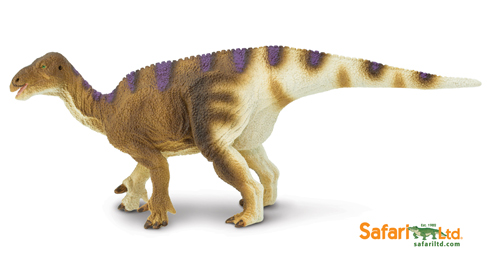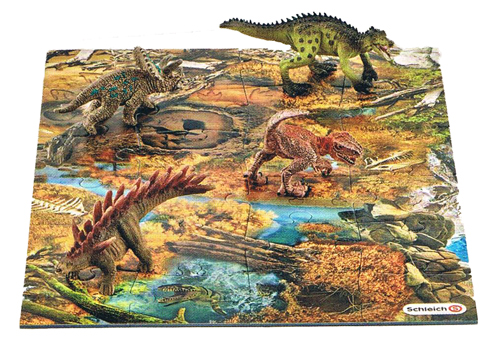New 2016 Prehistoric Animal Models from Safari Ltd
New Prehistoric Animal Models (Safari Ltd) 2016
With the news that Safari Ltd had ended its twenty-eight year partnership with the Carnegie Museum of Natural History, which broke in the spring, model collectors and dinosaur fans alike have been eagerly awaiting developments. What prehistoric animal models would come out in 2016? Everything Dinosaur can now reveal that information, the wait is over and enthusiasts of all things Dinosauria et al are not going to be disappointed.
Here are the new prehistoric animals:
- Plesiosuchus
- Iguanodon
- Masiakasaurus
- Shunosaurus
- Carcharodontosaurus
- Plus re-issues of previous Safari Ltd models, the baby Woolly Mammoth, the Megatherium (giant ground sloth), Amebelodon and the glyptodont Doedicurus.
Everything Dinosaur intends to stock all these items, we will do all we can to keep our customers and fellow prehistoric animal fans informed about deliveries into our warehouse.
Wild Safari Prehistoric World
There are a total of five new replicas, this is the same total as last year, the 1:10 scale Carnegie Collectibles Velociraptor, plus four not to scale models under the Wild Safari brand that has now become the flagship brand for prehistoric animal replicas the Florida-based company makes.
Let’s take a look at the new models in turn, firstly the Plesiosuchus model (marine crocodile). This Late Jurassic carnivore was one of the super predators of the shallow seas that covered much of Europe. It is estimated to have been around seven metres in length, approximately the size of the largest Saltwater crocodiles (Crocodylus porosus) found today. Plesiosuchus means “near crocodile” and is pronounced Plee-see-oh-sook-us. It was a member of the Metriorhynchoidea (pronounced Met-ri-oh-rink-oi-deer [A super family of the Crocodylomorpha]). It is great to see a model of a metriorhynchid from Safari Ltd.
New for 2016 the Wild Safari Dinos Plesiosuchus
Picture credit: Safari Ltd/Everything Dinosaur
The Plesiosuchus replica measures a fraction over seventeen centimetres and is around four and half centimetres tall (it’s the tail).
Now the Iguanodon model comes into focus. It is great to see another ornithopod in the Safari Ltd Prehistoric Life model collection.
New for 2016 the Wild Safari Dinos Iguanodon
Picture credit: Safari Ltd/Everything Dinosaur
Several Iguanodontid Models Made
Over the years, there have been a number of iguanodont models made, with the retirement of the Carnegie Collectibles Iguanodon replica, it is great to see this introduction. Iguanodon is brought bang up to date, the bipedal pose of the earlier model, launched in 2007 and effectively a re-paint of an even earlier Carnegie replica, has been replaced by a walking on all four limbs approach. The body proportions seem much more accurate and we love the thickened base of the tail.
These ornithopods were powerful animals and indeed the base of the tail and pelvis were very robust. The model has been given a striped colour scheme and we adore the flashes of purple, not a colour associated very often with dinosaur models. It is a nice touch. The model measures 18.5 cm by 7 cm.
New for 2016 – Shunosaurus
Picture credit: Safari Ltd/Everything Dinosaur
“Sauropod Crossed with a Llama”
The “sauropod crossed with a Llama”, as an Everything Dinosaur member of staff termed this replica when trying to decipher the double page advert that showed a glimpse of this figure, turns out to be a Shunosaurus. The colourful figure measures 16.5 cm in length and that detailed head stands around 7 cm high. One of the best known of all the Chinese Dinosauria, certainly the best known sauropod, thanks to the huge fossil assemblage excavated from the Dashanpu Quarry site (Sichuan Province). This looks like an excellent interpretation of the extensive fossil material. Well done Safari Ltd for bringing out such an interesting replica.
“Vicious Lizard” – Masiakasaurus
Picture credit: Safari Ltd/Everything Dinosaur
Masiakasaurus
A new fact sheet will be required for the fourth new prehistoric animal figure we are featuring here – Masiakasaurus, (the name means vicious lizard). An agile theropod that lived on the island of Madagascar in the Late Cretaceous. The forward pointing teeth have been very well depicted in this new for 2016 replica. We suspect that this is the first dinosaur model made by Safari Ltd, whose scientific name was inspired by a band member of Dire Straits.
The formal, binomial name for this two metre long terror is Masiakasaurus knopfleri. It was the music of Dire Straits’s front man Mark Knopfler that inspired the field team behind this particular dinosaur fossil discovery.
To read about the discovery and naming of another theropod dinosaur from Madagascar: New Dinosaur Discovery from Madagascar.
The design team at Safari Ltd have taken into careful consideration details of this dinosaur’s known skeleton (about two-thirds of all the bones in the skeleton have been described to date). Note the position of the hands and digits, although an abelisaurid, Masiakasaurus had proportionately much longer front limbs than other members of this theropod dinosaur family.
An Attractively Painted Model
It is an attractively painted model, the stripes and green markings are a good choice, it is likely that this dinosaur, required camouflage to help it avoid being spotted by larger meat-eaters that shared its floodplain environment.
The new Safari Ltd Masiakasaurus is around 18.5 cm in length and stands an impressive 8.25 cm tall.
New for 2016 – Carcharodontosaurus
Picture credit: Safari Ltd/Everything Dinosaur
Carcharodontosaurus
One of the largest theropods known, Carcharodontosaurus is a firm favourite amongst dinosaur fans and model collectors alike. It is great to see this interpretation by Safari Ltd. We had thought that the large, meat-eating dinosaur was going to be a megalosaur, we got wrong but we are delighted to see this North African monster join the Safari Ltd “Prehistoric Life” fold. At an impressive 22.75 cm long and standing 10.25 cm tall this is the biggest model dinosaur that Safari Ltd are bringing out next year.
To view Everything Dinosaur’s existing range of prehistoric animals from Safari Ltd: Wild Safari Prehistoric World Models.
Look out for announcements on Everything Dinosaur’s Facebook page, Twitter feed and on this blog site. More information including when they will be in stock will be posted up soon.

As seen in Prehistoric Times magazine, the Wild Safari Prehistoric World advert featuring some of the new prehistoric animal models.
Check out Everything Dinosaur’s Facebook page for pics of the prehistoric mammal models that are being re-introduced by Safari Ltd.
Find Everything Dinosaur on Facebook: Everything Dinosaur on Facebook.



































